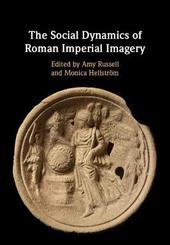
|
The Social Dynamics of Roman Imperial Imagery
Hardback
Main Details
| Title |
The Social Dynamics of Roman Imperial Imagery
|
| Authors and Contributors |
Edited by Amy Russell
|
|
Edited by Monica Hellstroem
|
| Physical Properties |
| Format:Hardback | | Pages:348 | | Dimensions(mm): Height 250,Width 180 |
|
| Category/Genre | Ancient and classical art BCE to c 500 CE |
|---|
| ISBN/Barcode |
9781108835121
|
| Classifications | Dewey:937 |
|---|
| Audience | | Professional & Vocational | |
|---|
| Illustrations |
Worked examples or Exercises
|
|
Publishing Details |
| Publisher |
Cambridge University Press
|
| Imprint |
Cambridge University Press
|
| Publication Date |
12 November 2020 |
| Publication Country |
United Kingdom
|
Description
Images relating to imperial power were produced all over the Roman Empire at every social level, and even images created at the centre were constantly remade as they were reproduced, reappropriated, and reinterpreted across the empire. This book employs the language of social dynamics, drawn from economics, sociology, and psychology, to investigate how imperial imagery was embedded in local contexts. Patrons and artists often made use of the universal visual language of empire to navigate their own local hierarchies and relationships, rather than as part of direct communication with the central authorities, and these local interactions were vital in reinforcing this language. The chapters range from large-scale monuments adorned with sculpture and epigraphy to quotidian oil lamps and lead tokens and cover the entire empire from Hispania to Egypt, and from Augustus to the third century CE.
Author Biography
Amy Russell is an Assistant Professor of Classics at Brown University. Until 2020 she was an Associate Professor of Classics and Ancient History at Durham University. Her research interests include the political history and topography of the Republic and early Empire. Her first book, The Politics of Public Space in Republican Rome (Cambridge, 2015), winner of the 2017 C.J. Goodwin Award of Merit, investigates the concept of public space and the construction and operation of the public/private divide in the Republican city of Rome. Other research projects tackle the building activity of the imperial Senate and the contributions of multiple groups to the creation of imperial imagery and ideology. She also works on Republican political history, with ongoing interests in the tribunate of the plebs and the role of the populus and the interactions between scholarship written in German and the Anglophone world. In 2018 she was awarded a Philip Leverhulme Prize. Monica Hellstroem is a Leverhulme Early Career Fellow in the Department of Classics and Ancient History at Durham University. She works on society and culture in the high and late Roman imperial periods, with a particular interest in visual culture. She has held the Fondazione Famiglia Rausing fellowship at the Swedish Institute in Rome. Her publications range from studies on historiography to church architecture, with current research topics including the communications and monumental output of the imperial government, inscriptions in North Africa, and the arts, social dynamics, and architecture of the city of Rome.
Reviews'... an original and well-structured volume.' Giovanni Alberto Cecconi, Bryn Mawr Classical
|